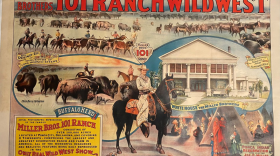Droughts, floods, and grasshoppers have posed daunting challenges for the North Dakota farmer. On this date in 1922, the Hope Pioneer warned of yet another threat. Tent caterpillars were expected to be quite active. Farmers were warned to be vigilant to keep the danger from getting out of hand.
There are two types of tent caterpillars. The eastern caterpillar makes their tent nests in the forks of trees. The forest caterpillar does not make tent nests. They move about in masses, crawling over trees, lawns, and outdoor furniture. Both species infest many different types of trees. These include ash, aspen, elm, maple, oak, and other hardwoods. Fortunately, neither species bites. They do, however, pose a significant threat to plant life. They spend the winter in the egg stage and hatch in the spring. They immediately begin to feast on the young foliage of trees and taller grasses. They eventually grow into moths.
If the tent caterpillar is eradicated after one year, the damage to plants is minimal. If they return for two or three years, the damage can be significant, and can even kill a tree. When tent caterpillar populations are high, their webs can cover entire trees.
In 1922 R.L. Walster, the entomologist for the North Dakota Experiment Station, urged farmers to remove and burn the web tents as soon as they were discovered. He said that if the tents were just thrown on the grown, the caterpillars would still hatch. Burning was a sure way to destroy them. Another method was to spray trees with arsenic water. The article stated that orchards sprayed with arsenic water rarely suffered damage from tent caterpillars. Tent caterpillar cocoons should be destroyed immediately if they were discovered to prevent the moth from hatching and laying eggs.
Tent caterpillars are still a challenge today. Orchard managers are advised to be alert to early signs of their presence. Insecticides designed to target tent caterpillars are available. There are also many natural predators that feed on the caterpillars. Robins, cardinals, blue jays, and other songbirds feed on them. Ground dwelling birds like turkeys will eat them if they are on the ground. If they fall in the water ducks and turtles will eat them. Some mammals like squirrels and bats are predators of the caterpillars. Supporting these natural predators is one of the best ways to deal with tent caterpillars.
Dakota Datebook written by Carole Butcher
Sources:
Hope Pioneer. “Effective Control of Caterpillars.” Hope, ND. 20 April 1922. Page 3.
North Dakota State University. “Crop and Pest Report.” https://www.ag.ndsu.edu/cpr/horticulture/tent-caterpillars-06-02-16 Accessed 3/20/20.



